Question Topic
Fireplace (Gas) Pilot Safety System

POLICY-Wizard™ calculates your ideal home care program to avoid problems with your Fireplace (gas), but sometimes trouble can still occur. Here are answers to questions about fireplace (gas) pilot safety system.
QUESTION FROM Dirty1788
what happens if the pil+I73ot light goes out on a vent free fireplace, will the gas continue to flow and fill up the room/house?
ANSWER FROM POLICY-Wizard™
Dear dirty1788:
The way most gas fireplaces are designed, the pilot safety system consists of three elements: a pilot burner; thermocouple located where it can be heated by the pilot flame; and a safety shut-off valve.
When the pilot is lit, it heats up the thermocouple. And when the thermocouple is heated, it generates a milli-voltage of electricity. This electrical current is what keeps the gas supply valve in the open position. When the pilot flame ever goes off, it the loss of heat causes the thermocouple to cool. This cooling reduces the milli-voltage, which causes the gas valve to return to it's normally closed position, thus shutting off the fuel supply to gas fireplace. The unit will not operate again the fireplace is manually restarted.
So, assuming that your gas fireplace is well-maintained and in good working order, if the pilot light goes out, gas will not continue to flow and fill up the room/house.
Also, another safety feature is that your vent-free gas fireplace should be equipped with Oxygen Depletion Sensor (ODS), which is designed to turn off the gas before carbon monoxide reaches a dangerous level in the room. However, it's still a good idea to install one or more carbon monoxide detectors in your home, no matter what type of fuel-burning appliance you have. Detectors are an inexpensive way to put your mind at ease about carbon monoxide levels, and their operation should be checked routinely.
Hope this is helpful.
Home-Wizard.com

 Overview
Overview Routine Care
Routine Care Q & A
Q & A Articles
Articles